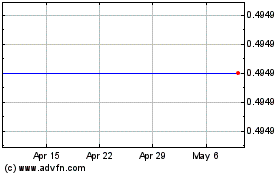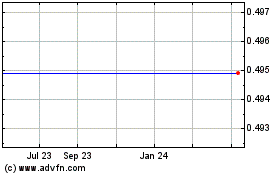Metacrine to Present Final Results from Phase 1 Trial of MET642, an Optimized FXR Agonist, at the 2021 NASH-TAG Conference
March 11 2021 - 6:30AM

Metacrine, Inc. (Nasdaq: MTCR), a clinical-stage biopharmaceutical
company focused on discovering and developing differentiated
therapies for patients with liver and gastrointestinal diseases,
today announced that final results from the company’s Phase 1 trial
of MET642, a farnesoid X receptor (FXR) agonist in development for
the treatment of non-alcoholic steatohepatitis (NASH), will be
presented as a distinguished abstract at the 2021 NASH-TAG
Conference. The conference is taking place March 11-13, 2021 in
Park City, Utah and virtually on-line.
Expanding on initial findings reported in December 2020, MET642
demonstrated both an encouraging safety and tolerability profile in
healthy volunteers, and sustained FXR target engagement after 14
days of daily oral dosing. There were no serious adverse events,
and all treatment-emergent adverse events were mild to moderate in
severity. MET642 exhibited significant FXR target engagement up to
24 hours after once-daily oral dosing, as evidenced by robust
suppression of 7α-hydroxy-4-cholesten-3-one (C4), a key
pharmacodynamic marker of FXR activation, at all dose levels. Of
equal importance, MET642 was not associated with increased levels
of low-density lipoprotein (LDL) cholesterol or reports of
pruritus, known side effects reported with other FXR development
candidates.
“We believe that a unique chemical scaffold and continuous
target engagement are key to optimizing the therapeutic benefits of
FXR agonism for the treatment of NASH,” said Hubert C. Chen, M.D.,
chief medical officer of Metacrine. “We are encouraged by the
overall clinical profile of MET642 to date. We are very pleased to
have recently initiated our Phase 2a trial in patients with NASH to
further elucidate the therapeutic potential of MET642 and look
forward to sharing interim data from that study later this
year.”
About the TrialThe MET642 Phase 1 trial was a
first-in-human, randomized, placebo-controlled, double-blind,
single-ascending dose (SAD) and multiple-ascending dose (MAD)
trial, in which healthy volunteers received a single oral dose of
MET642 ranging from 10 mg to 300 mg in the SAD cohorts and daily
oral doses ranging from 2.5 mg to 10 mg for 14 days in the MAD
cohorts.
About the Abstract“MET642, FXR agonist with a
unique chemotype, demonstrates a safe, sustained profile in a
14-day randomized study in healthy subjects”, is to be presented by
Richard Pencek, Ph.D., executive director of clinical science at
Metacrine. Co-authors include Kyoung-Jin Lee, Ph.D. and Jonathan
Lee.
About Non-alcoholic Steatohepatitis
(NASH)Non-alcoholic steatohepatitis, or NASH, is a liver
disease characterized by excess liver fat, inflammation and
fibrosis. In 2015, there were an estimated 17 million people in the
United States with NASH, which is expected to increase to an
estimated 27 million people by 2030. Left untreated, patients’
disease may progress to liver failure, which is life-threatening
without a successful liver transplant. NASH is expected to become
the leading cause for liver transplants in the United States.
Additionally, patients with NASH often present with metabolic
disease and other co-morbidities, which is likely to require
combination therapy. Currently, there are no approved therapies for
NASH.
About MetacrineMetacrine, Inc. (Nasdaq: MTCR)
is a clinical-stage biopharmaceutical company building a
differentiated pipeline of therapies to treat liver and
gastrointestinal (GI) diseases. Metacrine has developed a
proprietary farnesoid X receptor (FXR) platform utilizing a unique
chemical scaffold, which has demonstrated a differentiated and
improved therapeutic profile in clinical trials. The company’s two
product candidates, MET409 and MET642, are currently being
investigated in clinical trials as potential new treatments for
non-alcoholic steatohepatitis (NASH). MET409 has completed a
12-week monotherapy trial in patients with NASH and is being
evaluated in a 12-week combination trial with empagliflozin in
patients with both NASH and type 2 diabetes. MET642 has completed a
14-day Phase 1 trial in healthy volunteers and is being evaluated
in a 16-week monotherapy trial in patients with NASH.
Forward-Looking StatementsThis press release
contains forward-looking statements within the meaning of the
Private Securities Litigation Reform Act of 1995. Statements in
this press release that are not purely historical are
forward-looking statements. Forward-looking statements contained in
this press release include statements regarding the therapeutic
potential of MET642; the differentiated nature of Metacrine’s FXR
program; plans underlying Metacrine’s clinical trials; plans for
advancing the clinical development of Metacrine’s FXR program; and
the potential for its FXR product candidates to be long-term
therapies for NASH. Many factors may cause differences between
current expectations and actual results, including unexpected
safety or efficacy data observed during preclinical or clinical
studies and uncertainties related to the regulatory approval path
for the NASH indication. Words such as “may,” “could,” “will,”
“encourage,” “expect,” “plan,” “aim,” “anticipate,” “estimate,”
“intend,” “potential,” “prepare” and similar expressions (as well
as other words or expressions referencing future events, conditions
or circumstances) are intended to identify forward-looking
statements. These forward-looking statements are based on
Metacrine’s expectations and assumptions that may never materialize
or prove to be incorrect. Each of these forward-looking statements
involves risks and uncertainties. Actual results may differ
materially from those projected in any forward-looking statements
due to numerous risks and uncertainties, including but not limited
to: risks and uncertainties regarding regulatory approvals for
MET409 or MET642; potential delays in initiating, enrolling or
completing any clinical trials; potential adverse side effects or
other safety risks associated with Metacrine’s product candidates;
competition from third parties that are developing products for
similar uses; and Metacrine’s ability to obtain, maintain and
protect its intellectual property. Information regarding the
foregoing and additional risks may be found in the section entitled
“Risk Factors” in Metacrine’s Quarterly Report on Form 10-Q filed
with the Securities and Exchange Commission (the “SEC”) on November
12, 2020, and in Metacrine’s other filings with the SEC. All
forward-looking statements contained in this press release speak
only as of the date on which they were made. Except as required by
law, Metacrine assumes no obligation to update any forward-looking
statements contained herein to reflect any change in expectations,
even as new information becomes available.
Contact:Steve
Kunszaboinvestors@metacrine.com
Metacrine (NASDAQ:MTCR)
Historical Stock Chart
From Mar 2024 to Apr 2024

Metacrine (NASDAQ:MTCR)
Historical Stock Chart
From Apr 2023 to Apr 2024
